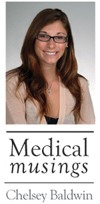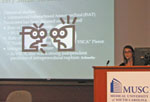|
Editor's
Note: Chelsey Baldwin of Little
River is a second-year medical
student.
This column follows the journey
of her class in becoming
doctors.
 It has
felt like the hottest summer ever.
I haven't checked the records or
anything, but I have contemplated
the supposed record highs each day
as I trudged through campus in the
sticky humidity. It has
felt like the hottest summer ever.
I haven't checked the records or
anything, but I have contemplated
the supposed record highs each day
as I trudged through campus in the
sticky humidity.
Every day,
similar routine: throw down my
million bags I've decided to
carry, pant in my office for five
minutes, which isn't really my
office, just one that I have taken
over for the summer, wipe down the
sweat with the sweatshirt I'll be
shivering in 30 minutes later, and
finally go see what Adrian is up
to.
Adrian Parker,
research coordinator for
radiology/neuro-interventional,
sits in the office next to mine.
This is extremely convenient
because Adrian is my access to all
data and happens to be
entertaining to sit next to as
well.
"Tell me if I'm
crazy," I preface my latest idea
for presenting the data I've
collected. The first step is
always bouncing ideas off Adrian.
The next step is translating
Adrian's response into either
"yes, you are indeed crazy" or a
"run it by Turk" answer. Dr.
Aquilla Turk is my mentor for my
summer project and usually my next
stop when playing with a new idea.
Turk's advice usually consists of
finding a smaller focus, a notion
I've been fighting since spending
over a month on data collection. I
secretly want to use it all in
some cleverly interwoven enormous
argument, but that isn't the way
it's done. I spent a good amount
of time this summer in the Summer
Health Professional Program being
acquainted with the way that
research is done.
During one such
attempt to direct my work, Dr.
Turk received a phone call about a
case that had just arrived in the
Emergency Department (ED)
involving a patient who had
experienced a stroke earlier that
morning. Dr. Turk was asked to
take a look at the computed
tomography scan (CT) of the
patient's brain. I began to
vibrate in my seat. While my
research has been focused down to
treatment of small aneurysms, I
was aware that Dr. Turk and his
colleagues use endovascular
approaches to treat stroke victims
as well. The thought of clicking
through medical records while this
case was going on was nearly
unbearable.
Before Dr. Turk
could finish explaining why our
meeting would be cut short, I had
already interjected, "Can I go?" I
followed Dr. Turk to the control
room where he scrolled through the
images of the stroke patient's
brain. While I'm far from an
expert in determining meaning of
these images, the sighs and
shaking of heads when a large dark
area comes across the screen
indicates that we have reached the
region of infarct. It was decided
in the control room that the
infarct wasn't significant and
that Dr. Imran Chaudry, a partner
of Dr. Turk, would take the case.
Scared of being
left to my record scrolling, I
look back and forth between Turk
and Chaudry. Turk notices me, "Oh
yeah, take Chelsey." With a grin,
I run off to go grab my white coat
and stuff its pockets with my note
pad, pens and anything else on my
desk that will fit.
Dr. Chaudry,
Dr. Eric Nyberg, the new
endovascular fellow, and I make
our way down to the ED. The first
room we enter is a rather small
control room.
One side of the
control room is made of glass,
through which I can see the
patient lying in a CT machine. Dr.
Chaudry and another attending
physician discuss and agree upon
the endovascular approach for
treatment.
Once consensus
is achieved among the physicians,
the tiny room begins to clear out
and I am able to approach the
screens displaying the latest
state of the patient's brain.
Chaudry points
out vessels to me. "Do you see
that there is a clot as low as the
ophthalmic artery?"
One fact about
the ophthalmic artery that has
stuck with me is that it's the
first branch of the internal
carotid, therefore I considered it
to be a pretty detrimental
location for blood flow to have
stopped. I look from the patient
on the table on the other side of
the glass, he is conscious and
appears to comprehend commands,
and then back to the image of his
blocked internal carotid artery,
slightly puzzled. Days later I was
reminded by Dr. Turk that the
patient's condition was possible
because a clot on the right
internal carotid will not greatly
affect the left side of the brain
where speech and speech cognition
are located.
As we finished
looking through the newest CT, the
patient was being moved back to
main area of the ED, so we
followed to obtain consent for the
upcoming procedure.
After the
patient signs, Dr. Nyberg brings
the form over to me, "See how he
only signs on the right-most
portion of the line?" I nod; I had
learned about one-sided neglect
due to impaired brain function in
the past year and saw how the
signature was crammed to one side
of the designated line. After the
patient made it upstairs to the
angio-suite for his procedure, I
resolved to go back to my
research. Back in the quiet, calm
of my office I sighed and
reluctantly restarted my data
collection.
This is not to
say that I don't enjoy research.
Sifting for data points can seem
extremely monotonous, especially
compared to the excitement of the
ED. However, pulling my data
together, running analysis and
drawing conclusions was a process
I enjoyed.
 Chelsey Baldwin
presents her research, "The
Treatment of Cerebral Aneurysms:
Does size matter?" July 28
during the final presentations
of the Summer Health
Professional Program. Chelsey Baldwin
presents her research, "The
Treatment of Cerebral Aneurysms:
Does size matter?" July 28
during the final presentations
of the Summer Health
Professional Program.
In my research
project, I was primarily looking
to see if the rate at which
patients came into MUSC with very
small cerebral aneurysms (smaller
than 4 mm)that had ruptured seemed
to dispute the existing literature
that suggests that this size
aneurysm essentially ruptures at a
non-significant rate.
I remember
recounting for a friend that in
these final phases I felt like I
was doing something that would
matter. If I am able to
effectively display that ruptured
very small cerebral aneurysms are
as clinically significant as any
other size, it may persuade other
physicians to treat this size of
aneurysm as aggressively as larger
aneurysms.
I gave my best attempt to cram my
findings and state my conclusions
in a 15-minute presentation at the
end of July. The presentation
really served as a good bench mark
in my attempt to convey my
findings; however, it is far from
the end point. I hope in another
year, I'll have a published paper
to show for my work this summer.
|



 It has
felt like the hottest summer ever.
I haven't checked the records or
anything, but I have contemplated
the supposed record highs each day
as I trudged through campus in the
sticky humidity.
It has
felt like the hottest summer ever.
I haven't checked the records or
anything, but I have contemplated
the supposed record highs each day
as I trudged through campus in the
sticky humidity.  Chelsey Baldwin
presents her research, "The
Treatment of Cerebral Aneurysms:
Does size matter?" July 28
during the final presentations
of the Summer Health
Professional Program.
Chelsey Baldwin
presents her research, "The
Treatment of Cerebral Aneurysms:
Does size matter?" July 28
during the final presentations
of the Summer Health
Professional Program.